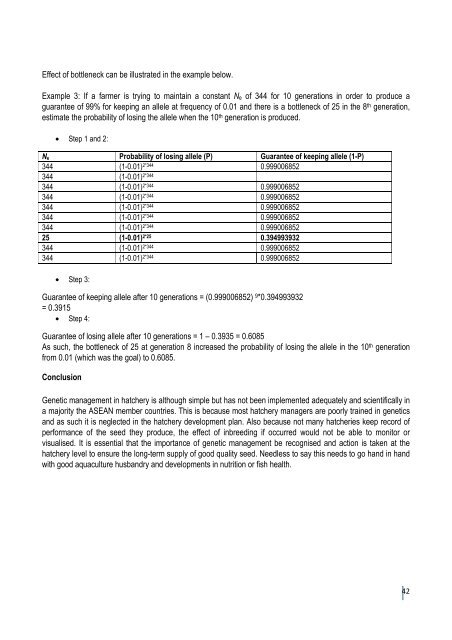Training of Trainers - Library - Network of Aquaculture Centres in ...
Training of Trainers - Library - Network of Aquaculture Centres in ...
Training of Trainers - Library - Network of Aquaculture Centres in ...
- No tags were found...
You also want an ePaper? Increase the reach of your titles
YUMPU automatically turns print PDFs into web optimized ePapers that Google loves.
Effect <strong>of</strong> bottleneck can be illustrated <strong>in</strong> the example below.Example 3: If a farmer is try<strong>in</strong>g to ma<strong>in</strong>ta<strong>in</strong> a constant Ne <strong>of</strong> 344 for 10 generations <strong>in</strong> order to produce aguarantee <strong>of</strong> 99% for keep<strong>in</strong>g an allele at frequency <strong>of</strong> 0.01 and there is a bottleneck <strong>of</strong> 25 <strong>in</strong> the 8 th generation,estimate the probability <strong>of</strong> los<strong>in</strong>g the allele when the 10 th generation is produced.• Step 1 and 2:N e Probability <strong>of</strong> los<strong>in</strong>g allele (P) Guarantee <strong>of</strong> keep<strong>in</strong>g allele (1-P)344 (1-0.01) 2*344 0.999006852344 (1-0.01) 2*344344 (1-0.01) 2*344 0.999006852344 (1-0.01) 2*344 0.999006852344 (1-0.01) 2*344 0.999006852344 (1-0.01) 2*344 0.999006852344 (1-0.01) 2*344 0.99900685225 (1-0.01) 2*25 0.394993932344 (1-0.01) 2*344 0.999006852344 (1-0.01) 2*344 0.999006852• Step 3:Guarantee <strong>of</strong> keep<strong>in</strong>g allele after 10 generations = (0.999006852) 9 *0.394993932= 0.3915• Step 4:Guarantee <strong>of</strong> los<strong>in</strong>g allele after 10 generations = 1 – 0.3935 = 0.6085As such, the bottleneck <strong>of</strong> 25 at generation 8 <strong>in</strong>creased the probability <strong>of</strong> los<strong>in</strong>g the allele <strong>in</strong> the 10 th generationfrom 0.01 (which was the goal) to 0.6085.ConclusionGenetic management <strong>in</strong> hatchery is although simple but has not been implemented adequately and scientifically <strong>in</strong>a majority the ASEAN member countries. This is because most hatchery managers are poorly tra<strong>in</strong>ed <strong>in</strong> geneticsand as such it is neglected <strong>in</strong> the hatchery development plan. Also because not many hatcheries keep record <strong>of</strong>performance <strong>of</strong> the seed they produce, the effect <strong>of</strong> <strong>in</strong>breed<strong>in</strong>g if occurred would not be able to monitor orvisualised. It is essential that the importance <strong>of</strong> genetic management be recognised and action is taken at thehatchery level to ensure the long-term supply <strong>of</strong> good quality seed. Needless to say this needs to go hand <strong>in</strong> handwith good aquaculture husbandry and developments <strong>in</strong> nutrition or fish health.42
















